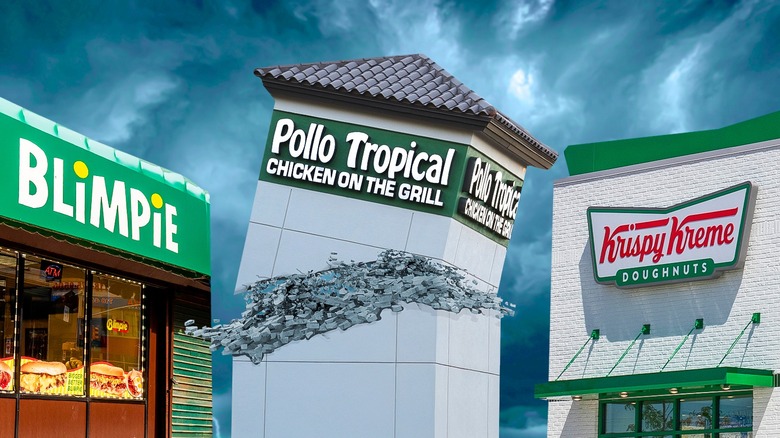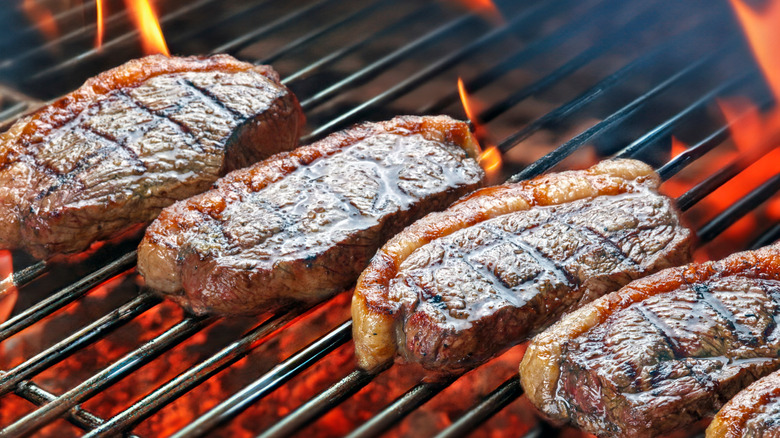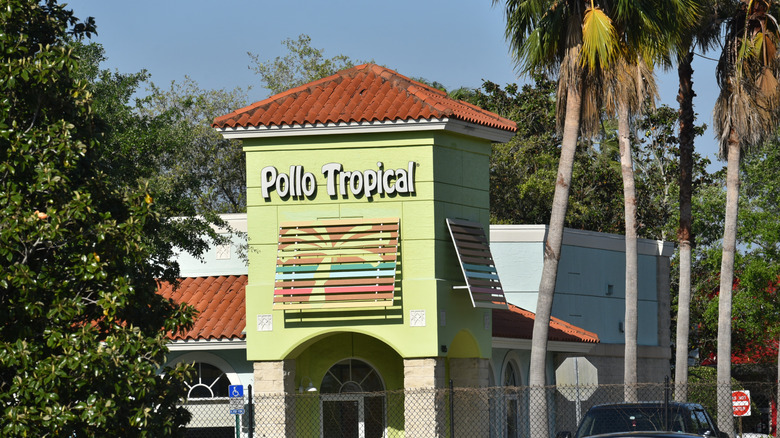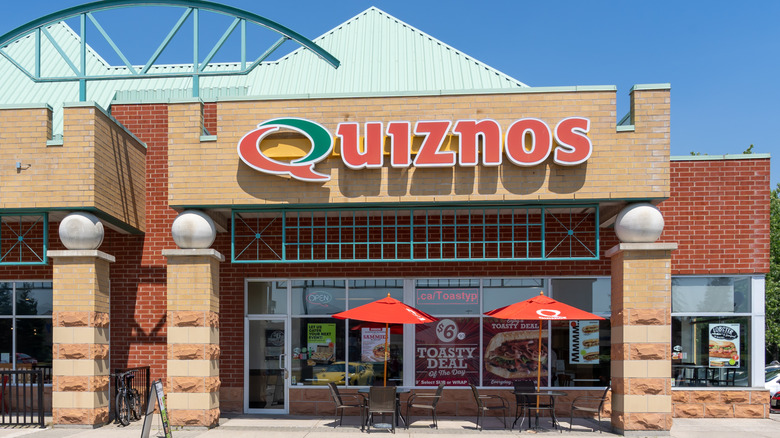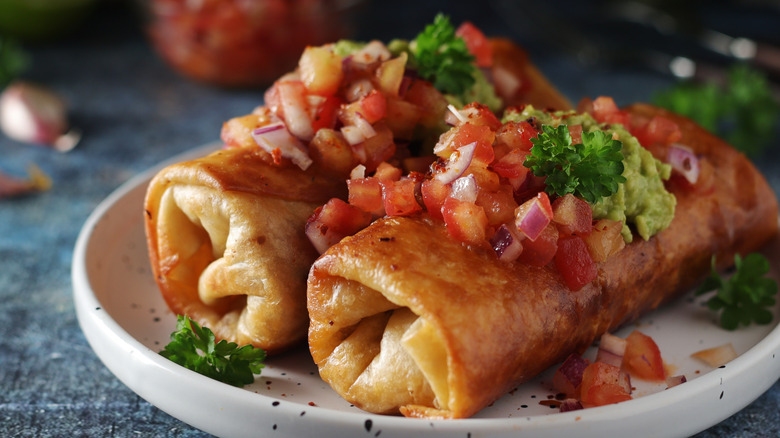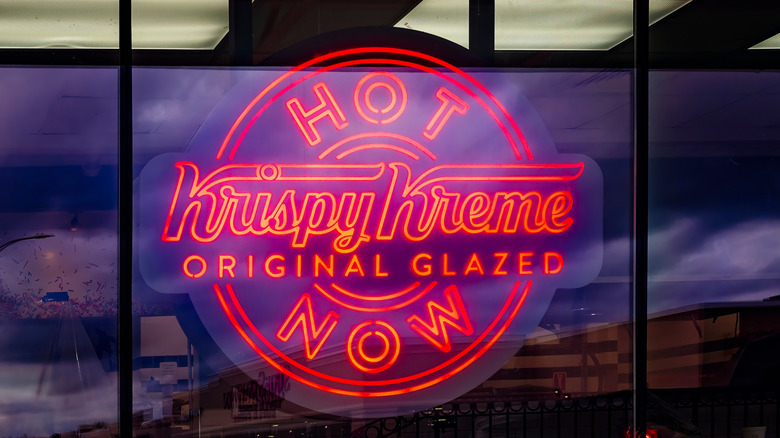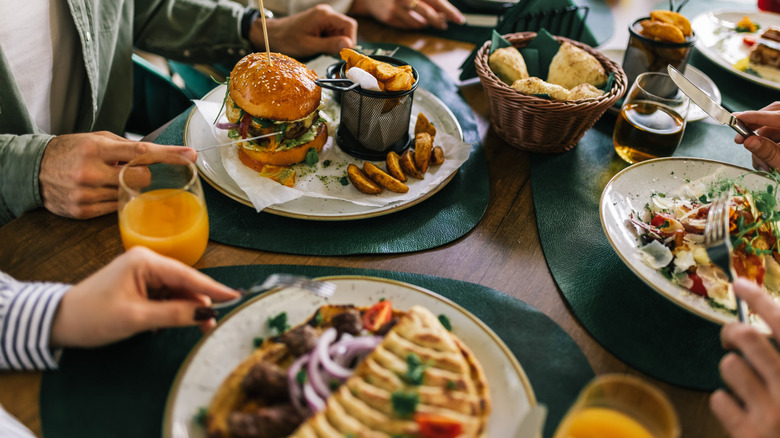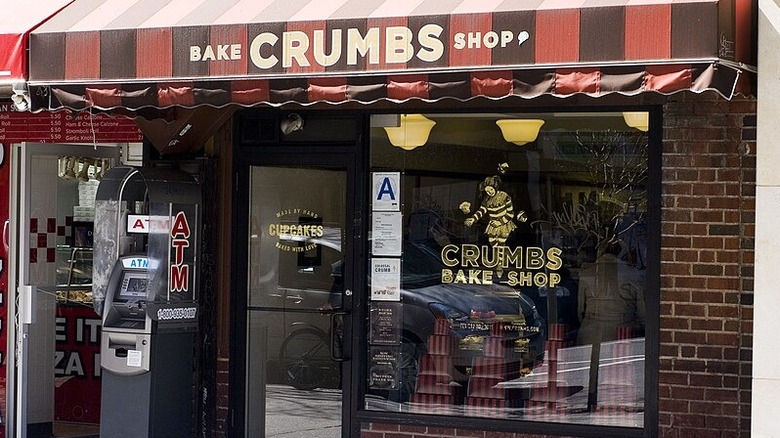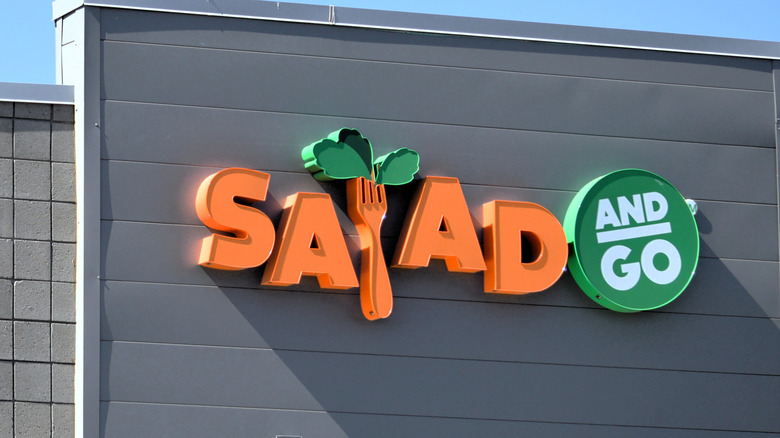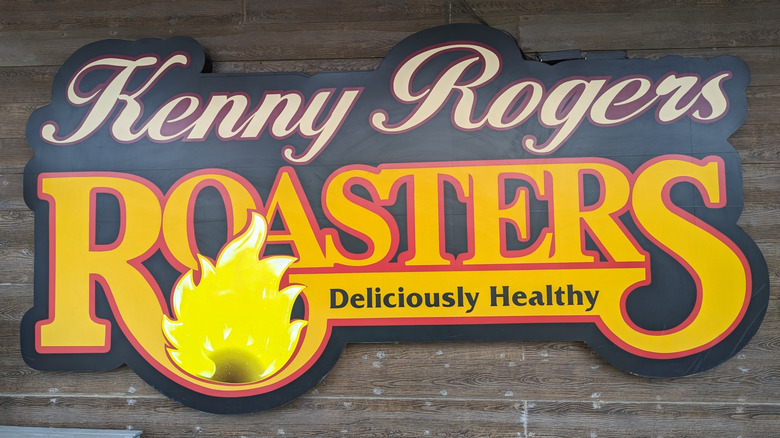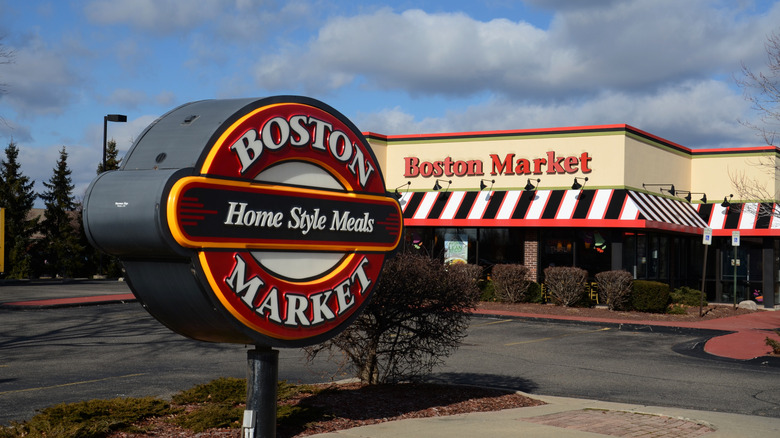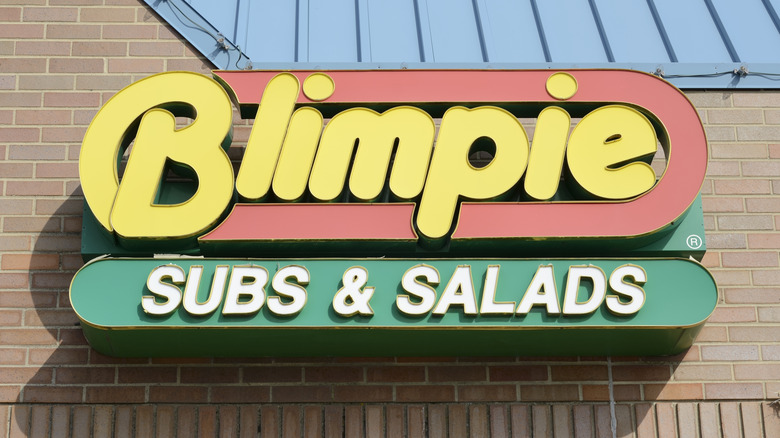Restaurant Chains That Expanded Too Fast And Paid The Price
The grand opening of a popular restaurant's new location can be quite a spectacle: lots of balloons, lots of hype, and lots of people willing to wait in line for hours for their first taste of the food they've only heard about, or to see if the food still tastes as good as they remember from when they ate there in their childhood or on vacation.
According to restaurantdata.com, there are 550-650 restaurant grand openings every week in the U.S. For some, it's the first location; for others, it's the 1,000th. While some restaurants grow at a slow pace, others seem addicted to the thrill of rapid expansion. But there is such thing as too much of a good thing, and restaurants can become burdened with an overabundance of stores and a lack of customers. Restaurant chains that expand quickly are especially vulnerable to both internal and external problems. Sometimes business strategies don't scale successfully, and chains lose consistency in quality, training, and sourcing. Many flash-in-the-pan restaurants entered the market at the right time to cash in on a food trend but didn't adapt when the fad fizzled. Others entered the market at the wrong time and were sidelined by a recession, pandemic, cultural shift, or aggressive competition.
While there are endless examples of failed restaurants we wish would make a comeback after they expanded too quickly and paid the price, here are 11 we think have a particularly interesting story — and some even have a happy ending.
Lone Star Steakhouse and Saloon
One lone location – in Guam – is all that remains of the 265 locations of Lone Star Steakhouse, one of several once-popular restaurant chains that now barely exist. But in the '90s, the restaurant, which specialized in mesquite-grilled steak, seafood, and salads, was everywhere.
Owner Jamie Coulter, who had previously owned Pizza Hut's largest franchise, began building an empire, opening new restaurants and buying up struggling restaurants. The expeditious growth caught the attention of the business world and Forbes Magazine named Lone Star the Best Small Company in 1993, 1994, and 1995, and number six on the its 1994 list of the 100 fastest-growing companies – higher than any other restaurant.
With success secured in the casual dining steakhouse market, Coulter ventured into the up-scale sector, developing and acquiring higher-end steakhouse chains. Meanwhile, several other competitors, including Outback Steakhouse, which had an almost identical menu to Lone Star, was staking its claim to the steakhouse market share. Lone Star began to cut corners, trim the fat, scrimp on the shrimp, and be frugal with the filet mignon, as one food writer experienced when she was served a few pieces of low-quality sirloin — held together with a toothpick and wrapped in bacon — being sold as a filet mignon. Sales sank, which frustrated stockholders — who sued Coulter, and franchisees — who ousted him from the board. In 2017, Lone Star filed for bankruptcy and closed the doors on its U.S. locations.
Pollo Tropical
In 1998, Pollo Tropical spiced up Florida's fast-casual restaurant with its Caribbean-inspired menu. The chargrilled, citrus-marinade chicken instantly struck a chord with Floridians. The chain expanded aggressively and successfully — between 2012 and 2015, its value more than quintupled. Riding the wave of success, Pollo Tropical spread inland. In many areas, it was a smooth ride, but in others, it was more of a wipeout. Texans and Georgians had no appetite for the Caribbean concept, and in less than three years, almost all locations outside Florida closed.
In 2017, the chain's parent company, Fiesta Restaurant Group, installed a new CEO who slowed growth to keep the restaurant's head above water. He explained to NRN, "In hindsight, Fiesta simply went too far, too fast with the Pollo Tropical store development. This taxed our ability to consistently operate restaurants with a level of execution that built this great brand."
Authentic Restaurant Brands took over in 2023 and limited franchises and refocused to maintain consistency in service and profits at existing locations. The strategy included simplifying the menu, expanding profitable practices, and promoting its strengths, like its competitively-priced family chicken meal. Pollo Tropical has successful stores in Puerto Rico and the Bahamas, but growth in the U.S. is cautious and exclusively in Florida, with all other U.S locations now defunct.
Quiznos
Quiznos was once the hot new restaurant, differentiating itself from other sandwiches shops by broiling its subs until they were "mmmm ...toasty!" Anxious to get ahead of other sandwich chains, Quiznos cooked up an aggressive growth strategy after its initial success. However, the company got burned by a hot and hurried expansion. The company neglected to research potential markets, and many franchise owners realized too late that they were located in a slow area, had a building that was difficult to see or access, or were in direct competition with another nearby Quiznos franchise. Furthermore, opening new stores was profitable for those at the top but not for the franchise owners who were constrained by the company's profit-oriented supply chain, which stretched their budgets and left them vulnerable in the 2008 recession.
Quiznos' marketing team, once innovative, became so hyper-focused on beating Subway, it lost its brand identity. Even though Quiznos used higher quality ingredients, it was unable to stand out against Subway's successful Fresh Fit menu. And financially, it couldn't compete with Subway's $5 footlongs or low franchise startup costs. Quiznos battled franchise owners and changing food trends for a years until, despite having been the second-largest submarine sandwich chain in 2013, the company filed for bankruptcy and initiated store closures.
There are still 148 U.S, and 183 international locations, but Quiznos is still considered a struggling sandwich chain, because, at its peak in the mid-2000s, it had 5,000 locations.
Chi-Chi's Mexican Restaurante
During the 70s and 80s, Chi-Chi's was where many Midwesterners got their first taste of chimichangas and fried ice cream. With no competition from any other Mexican restaurants, every store opening was a fiesta and expansion didn't stop for a siesta. However, when Chi-Chi's attempted to enter markets with a well-established Mexican food presence, it couldn't take the heat. One Takeout writer explained what happened when people tasted Chi-Chi's food, that the "Tex-Mex" flavors were more subtle than the spiciness people expected from Mexican fare. Still, many people loved the chain's food and festive atmosphere, and by 1986, there were 237 locations.
However, within a few years, Chi-Chi's began to struggle due to internal miscommunication and increased competition, in some cases from its own franchises. Restaurants with large dining rooms, located in close proximity to each other, had made sense during the peak in popularity, but were now competing for the same customers. The chain experienced its best earning year in 1990. But as it neglected restaurant remodels and menu updates, customers took their business elsewhere. The business filed for bankruptcy in 2003, and then a few months later, an outbreak of foodborne illness in one of its stores killed four customers and made 636 others sick.
Decades later, people still remember the outbreak, but also their fond memories, which is why Chi-Chi's is often on the list of failed restaurants people wish would make a comeback. So when the original owner's son opened a Chi-Chi's in October 2025, the response was positive.
Krispy Kreme
Since the first Krispy Kreme opened in 1937, generations of doughnuts lovers have fallen for the hot, melt-in-your mouth glazed doughnuts. Initially only Southerners had access to the secret recipe doughnuts (it's the potato flour), but in the 1980s, the doughnut shop finally expanded north. Through the mid-90s to early 2000s, Krispy Kreme was all the rage, featured in episodes of "Sex and the City" and "Friends," and hyped up by famous folks like Rosie O'Donnell and President Bill Clinton.
By 2003, demand for Krispy Kreme boiled over with 3 billions doughnuts a year being sold world-wide, and people waiting in line for hours at new locations. Yet, just a few years later, as the low-carb fad heated up, KK”s sales failed to rise and it was deep-fried in debt. Once popular locations went stale and were closed. Expansion efforts cooled and (room temperature) Krispy Kreme doughnuts were sold at grocery and convenience stores. In 2024, Krispy Kreme abruptly backed out of a collaboration deal with McDonald's, which Fortune magazine said typifies the complexities and costs of scaling niche products in the increasingly competitive fast food landscape.
The story of Krispy Kreme is not so much about the financial effect of rapid expansion, but how it diluted the magic of the brand. As a longtime Krispy Kreme employee lamented to the Phoenix Sun, when the Hot Now neon glow became just part of a store's regular signage, and not the fresh batch clarion call for doughnut lovers, "something in my heart broke just a little bit."
Ground Round
Ground Round's story is unique because it was never meant to grow so large. The first location opened in 1969, but its parent company was more focused on expanding its Howard Johnson restaurants which catered to travelers. Then the 1973 oil crisis caused gas prices to soar and the families stopped taking road trips. That's when the company looked to Ground Round, with its community-building concept, to save the day.
Ground Round expanded throughout the Northeast and Midwest during the '70s and '80s, specializing in classic American comfort food. The restaurant showed movies on big screens, priced kids meals based on the child's weight, served ice cream in mini baseball cap cups and hosted birthday parties. The restaurant's mascot, Bingo the Clown brought peanuts to the customers and encouraged them to throw their shells on the floor. (Peanuts were later changed to popcorn.)
However, growth stalled when the restaurant changed owners multiple times, leaving store renovations neglected, innovations lagging, and debt compounding. In 2004, the company defaulted on millions of dollars of debt, and store managers were instructed to close their doors immediately. Even though it was dinner service on Valentine's Day weekend, employees and customers were hastily ushered out of dozens of locations.
Only four franchise locations remained in operation in 2024, however, a Massachusetts couple with fond memories of the restaurant of their youth bought the branding rights. In 2025, they opened a reimagined modern Ground Round restaurant in Shrewsbury, Massachusetts, the city of the original franchise.
Crumbs Bakeshop
Crumbs Bakeshop opened in 2003 in New York, the sweet spot for the cupcake craze that was whipped up by fans of "Sex and the City" who saw their favorite characters eating gourmet cupcakes in a third season episode. The Manhattan store quickly won over sweet-toothed consumers with oversized cupcakes in 50 different flavors and grew into a cupcake empire with around 50 locations within 11 years. The bakery was recognized by Inc. Magazine as one of the country's 500 fastest growing private companies in 2010. Crumbs reported it was selling over a million cupcakes a month at its peak.
But when the cupcake trend came to an end, so did the company. The demand for cupcakes crumbled, and having failed to diversify the menu, the shop owners were left scrambling for crumbs. All locations were closed by 2016.
Fast forward nine years, when the original owners, Mia and Jason Bauer, who had sold their then thriving company in 2012, paid $350 to get their trademark back and threw a cupcake comeback party. Crumbs still has a broad customer base but it won't be appearing on any lists of best bakeries in each state, because its cupcakes, cookies and other sweet treats can only be purchased through an online store or in the bakery section of supermarkets and convenience stores. That's why when Crumbs introduced a 4.25 pound Colossal Cupcake, it became a viral trend on social media for shoppers to document their search for the party-sized treat in their local stores.
Salad and Go
Salad and Go opened in Arizona in 2013 as a vegetable-forward alternative to fast food. As a drive-thru only restaurant, it offered quick and healthy bites on the go for breakfast, lunch, snacks, and dinner. What set it apart from other salad restaurants, besides its hearty bowls, wraps, smoothies, and variety of flavored lemonades, ice teas and juices, was its $7 price point, which was considerably lower than similar competitors. Customers appreciated the restaurant's convenience, high quality ingredients, and charity initiatives which benefited local communities.
The chain quickly expanded into Texas, Nevada, and Oklahoma. The small restaurants were successful financially because they had low overhead costs and the fresh ingredients were sourced locally which saved on transportation costs. The restaurants weren't large making it easy to secure new locations and the number of locations more than doubled between 2020-2022. In 2023, Salad and Go was building at a rate of nearly one store each week and closed out 2024 with 146 stores.
Ultimately the rapid expansion made it difficult for the restaurant to invest in innovation and brand recognition, and in September 2025, the company closed 28% its stores to focus resources on the most successful locations.
Kenny Rogers Roasters
What do you get when you cross a former KFC CEO and a country music legend? A Kenny Rogers Roasters restaurant selling juicy chicken that is no joke!
After John Y. Brown Jr helped KFC grow its chicken empire, the former KFC CEO (and former Kentucky governor,) decided the world was ready for a healthier alternative to fried chicken, so he teamed up with country singer Kenny Rogers to open a new restaurant chain. Kenny Roger's Roasters' slogan promised "less fat, less salt, less calories" with rotisserie chicken cooked in a wood-fire oven. The original location was a hit and within a few years, Kenny Rogers Roasters had more than 350 locations in malls, shopping centers, and stand alone restaurants.
Kenny Rogers' name was on the logo and he appeared in TV commercials, but otherwise he wasn't involved in the business, which is probably why, in a blind taste test he chose cafeteria chicken over his own restaurant's chicken. In his defense, rotisserie chicken was the hot new trend at the time (even though it was actually an old cooking technique which Napoleon preferred.)
The restaurant chain faced fierce competition, not to mention a lawsuit from rival chain Cluckers. Eventually, Kenny Rogers Roasters lost the chicken wars, and following a 1998 bankruptcy, it began closing its 425 restaurants, with the final location holding on until 2011. There are numerous locations in Asia, but here in the U.S., it remains one of the restaurants many people wish would make a comeback.
Boston Market
Boston Market was another major player in the fast-growing, fast-casual market of the '90s. Customers were thrilled with the menu of rotisserie chicken, mashed potatoes, creamy mac-n-cheese, and other comfort foods as alternative to fast food, and Boston Market was thrilled to have packed restaurants.
By 1996, the restaurant had revealed plans to triple the number of restaurants in less than seven years. While it never reached its goal of 2,700 stores, the chain still dominated the market at its peak with over 1,100 locations. However, over-enthusiastic growth outpaced the customer base and soon Boston Market had over-saturated the market.
Under significant financial strain, stores began to fail. In 2024, the majority of its remaining locations closed when Boston Market faced multiple lawsuits for failure to pay vendors and was denied a Chapter 11 bankruptcy. As of 2025, there only 74 locations. However, Boston Market's impact is still relevant today. Even though it could not maintain its success, it did help inspire supermarkets to sell rotisserie chicken. Today, most grocery chains still offer whole chickens at low prices.
Blimpie
Blimpie, which calls itself America's Sub Shop, was the idea of three friends who were inspired by the submarine sandwich they had tasted at Mike's Subs, which later became Jersey Mike's (which we named one of the fastest growing but underrated chains a few years ago.) Blimpie cold cuts sandwiches were an instant hit at the first location in Hoboken, New Jersey. And even though they had little business experience, the trio figured they'd found a rich market so they opened two more locations within the next three months. Tony Conza, one of the founders, told the Hudson Reporter, "We didn't even know what we were doing. But we loved it."
Unfortunately, the young men were a little green in their method to make some green when they reinvested their profits into expansion efforts. Soon they had stacked up serious debt. They began to sell franchises to stay in the game. When expansion problems slowed sales, the lone remaining original owner began an unconventional strategy of setting up shops on college campuses and in hospitals, even creating mobile kiosks to sell a limited menu at sports arenas and fairs.
Blimpie experienced its most explosive decade of growth in the '90s, expanding from 200 locations to 2,000. But with competition from several other sandwich chains, and an unsustainable expansion habit, Blimpie changed hands a few times and the next decade saw 50% of its locations close. In 2025, there were just 95 Blimpie locations in the U.S.
